Gram staining by RKL.pptx
•Download as PPTX, PDF•
0 likes•5 views
Principle & procedure of Gram Staining
Report
Share
Report
Share

Recommended
Recommended
More Related Content
Similar to Gram staining by RKL.pptx
Similar to Gram staining by RKL.pptx (20)
403149684 stainingtechniquesgp-150203151421-conversion-gate02-pdf

403149684 stainingtechniquesgp-150203151421-conversion-gate02-pdf
Gram staining Gram positive and gram negative bacteria can be distinguished b...

Gram staining Gram positive and gram negative bacteria can be distinguished b...
More from Rahul Lodha
More from Rahul Lodha (9)
Recently uploaded
Recently uploaded (20)
TEST BANK For Radiologic Science for Technologists, 12th Edition by Stewart C...

TEST BANK For Radiologic Science for Technologists, 12th Edition by Stewart C...
SAMASTIPUR CALL GIRL 7857803690 LOW PRICE ESCORT SERVICE

SAMASTIPUR CALL GIRL 7857803690 LOW PRICE ESCORT SERVICE
GUIDELINES ON SIMILAR BIOLOGICS Regulatory Requirements for Marketing Authori...

GUIDELINES ON SIMILAR BIOLOGICS Regulatory Requirements for Marketing Authori...
VIRUSES structure and classification ppt by Dr.Prince C P

VIRUSES structure and classification ppt by Dr.Prince C P
Pulmonary drug delivery system M.pharm -2nd sem P'ceutics

Pulmonary drug delivery system M.pharm -2nd sem P'ceutics
Forensic Biology & Its biological significance.pdf

Forensic Biology & Its biological significance.pdf
Nightside clouds and disequilibrium chemistry on the hot Jupiter WASP-43b

Nightside clouds and disequilibrium chemistry on the hot Jupiter WASP-43b
Botany krishna series 2nd semester Only Mcq type questions

Botany krishna series 2nd semester Only Mcq type questions
Chemical Tests; flame test, positive and negative ions test Edexcel Internati...

Chemical Tests; flame test, positive and negative ions test Edexcel Internati...
Recombination DNA Technology (Nucleic Acid Hybridization )

Recombination DNA Technology (Nucleic Acid Hybridization )
All-domain Anomaly Resolution Office U.S. Department of Defense (U) Case: “Eg...

All-domain Anomaly Resolution Office U.S. Department of Defense (U) Case: “Eg...
Seismic Method Estimate velocity from seismic data.pptx

Seismic Method Estimate velocity from seismic data.pptx
High Class Escorts in Hyderabad ₹7.5k Pick Up & Drop With Cash Payment 969456...

High Class Escorts in Hyderabad ₹7.5k Pick Up & Drop With Cash Payment 969456...
Gram staining by RKL.pptx
- 1. By Mr. R. K. Lodha Topic GRAM STAINING OF MICROBES
- 8. Thin layer About 1 min. About 1 min. About 10 sec. About 30 sec.-1 min.
- 9. GRAM STAINING PROCEDURE Prepare a heat fixed smear of the culture you wish to examine Flood the smear with crystal violet (30 sec. to 2 min) Quickly and gently wash off excess stain (2 seconds) Flood the smear with Grams iodine (1 minute) Decolorize with alcohol (10-20 seconds or until the excess alcohol which flow off the slide is colorless) Quickly and gently wash off excess stain (2 seconds) Flood the smear with safranin (carbolfuchsin) (30 sec to 2 min.) Quickly and gently wash off excess stain (2 seconds) Blot dry with bibulous paper/tissue paper Examine your slide under the microscope Record sketches of the organisms, size, color, morphology, and culture identification.
- 11. GRAM STAIN PROCEDURE 1. Gently flood the smear with crystal violet and leave for 1 minute. Tilt the slide slightly and gently rinse with tap water or distilled water. Crystal violet is a water-soluble dye which enters the peptidoglycan layer in the bacterial cell wall. 2. Gently flood the smear with Gram’s iodine and leave for 1 minute. Tilt the slide slightly and gently rinse with tap water or distilled water. The smear will now appear purple. Gram's iodine solution (iodine and potassium iodide) is added to form a complex with the crystal violet, which is much larger and is insoluble in water. 3. Decolorize the smear using 95 % ethyl alcohol or acetone. Tilt the slide slightly and apply the alcohol drop by drop until the alcohol runs almost clear (5-10 seconds). Immediately rinse with water to avoid over-decolorizing. Decolorizer dehydrates the peptidoglycan layer, shrinking and tightening it. In Gram positive bacteria, the large crystal violet-iodine complexes are then unable to penetrate and escape the thick peptidoglycan layer, resulting in purple stained cells. However, in Gram negative bacteria, the outer membrane is degraded, the thin peptidoglycan layer is unable to retain the crystal violet-iodine complexes and the color is lost. 4. Gently flood with safranin counterstain and leave for 45 seconds. Tilt the slide slightly and gently rinse with tap water or distilled water. Safranin is weakly water soluble and will stain bacterial cells a light red, enabling visualization of Gram negative cells without interfering with the observation of the purple of the Gram positive cells. 5. Blot the slide dry on filter paper then view the smear using a light-microscope under oil-immersion.
- 14. GRAM POSITIVE VS GRAM NEGATIVE COLOR Gram positive bacteria Gram positive bacteria have a distinctive purple appearance when observed under a light microscope following Gram staining. This is due to retention of the purple crystal violet stain in the thick peptidoglycan layer of the cell wall. Examples of Gram positive bacteria include all staphylococci, all streptococci and some listeria species. Gram negative bacteria Gram negative bacteria appear a pale reddish color when observed under a light microscope following Gram staining. This is because the structure of their cell wall is unable to retain the crystal violet stain so are colored only by the safranin counterstain. Examples of Gram negative bacteria include enterococci, salmonella species and pseudomonas species.
- 16. Thank You
